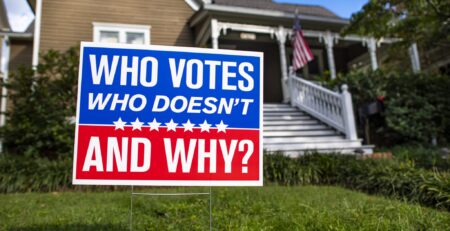written by Josh Green
written by Josh Green
“We have a problem in our country. It’s a new problem,” President Trump told reporters in a White House meeting last September. “It’s a problem nobody really thought about too much a few years ago, and it’s called ‘vaping’ — especially vaping as it pertains to innocent children.”
Walk down nearly any street in America today, and you’ll see young people sucking on the end of what looks like a fancy pen or portable USB drive, then exhaling a cloud of vapor. Recent large-scale surveys have indicated more than 10 percent of American middle-school students vaped in 2019. At the high school level, more than a quarter of students vape regularly, even as cigarette use has decreased.
This alone has sparked something of a panic among public health experts, educators and parents. Then in summer 2019, young patients began to show up in emergency rooms across the country with coughing, chest pain and severe shortness of breath. It was the beginning of a national outbreak of what’s now been dubbed EVALI, or e-cigarette (vaping) product use-associated lung injury. As of February, more than 2,800 people have been hospitalized and 68 people have died.
The coronavirus, which targets the lungs, may represent yet another increased health risk for tobacco users. “At this time, it is particularly important to protect the health of our lungs, and an ideal time (and another reason) to quit smoking now and forever,” says Michael Eriksen, interim vice president for research and economic development at Georgia State and founding dean of the School of Public Health.
Eriksen leads Georgia State’s tobacco team, which he calls “one of the world’s leading group looking at the broad issues of e-cigarettes and novel tobacco products.” Combining backgrounds in chemistry, psychology, physiology, economics, public policy and other disciplines, the group has studied e-cigarette policy, marketing and communication, the design of the product and the engineering of nicotine delivery.
“To really understand it, you need expertise,” says Georgia State economist Jidong Huang, an associate professor of health management and policy. “One of our unique strengths is we’ve been able to look at this issue from different perspectives to put together a holistic approach.”
Recent large-scale surveys have indicated more than 10 percent of American middle-school students vaped in 2019.
THE DECLINE OF SMOKING AND THE RISE OF VAPING
Back in the 1950s and 1960s, cigarettes were everywhere. Commercials featured “The Flintstones’” Barney and Fred, puffing away against prehistoric rocks. Colorful magazine advertisements showed housewives lighting up while lounging around the house, enjoying “more pure pleasure” via smokes that were so “rich-tasting, yet so mild!”
The ubiquity of cigarettes is something today’s youth can hardly fathom.
“You talk to college students today and you tell them one-third of the seats on airplanes used to be reserved for smokers, and their response is, ‘Get out of here — that’s crazy!’” says Eriksen, who previously headed the Centers for Disease Control and Prevention’s Office of Smoking and Health.
Before vaping, teen tobacco use has declined since the mid-1990s, thanks to a decades-long effort by health professionals to break America’s addiction to nicotine. Today, just over 13 percent of adult Americans are cigarette smokers, and the rates are even lower among high school students, a key demographic for cigarette manufacturers because most adults now find the habit too insidious to start.
Tobacco companies initially turned to e-cigarettes as a way of hooking new customers and sating smokers’ addiction without killing them. (Of the 2 million American deaths each year, one in five is linked to smoking.) But the products struggled to find an allegiant market. The main problem, according to Georgia State School of Public Health professor David Ashley, was that first-generation e-cigarettes mimicked a cigarette’s taste but failed to sufficiently deliver nicotine to users.
“Initially, e-cigarettes really looked like they were going to be a product that nobody would be interested in,” says Ashley, who spent seven years as director of the Office of Science in the Center for Tobacco Products at the U.S. Food and Drug Administration.
That all changed in roughly the past decade, when technology caught up and companies devised ways to create devices that could deliver larger doses of nicotine, faster. Sleek pens and other devices by the names of Vuse, Njoy, and blu were introduced, and “vaping” became a more common behavior. Then came JUUL, and the market exploded.
HOW A NICOTINE ALTERNATIVE BECAME “A MESS”
JUUL appeared on U.S. shelves as a relatively obscure product in summer 2015. But within a few years, it had captured more than 70 percent of the retail e-cigarette market and become the most used e-cigarette brand among American youth, of which 5 million are e-cigarette customers. It even spawned a new verb, “juuling.” Today, just 5.8 percent of high school students smoke cigarettes — but 27.5 percent vape.
Part of what drove JUUL’s runaway success was its unique engineering of nicotine salts to deliver a bigger, faster nicotine hit than competing products. Another was its marketing efforts targeting young adults and even kids, according to a recent lawsuit that alleges JUUL took out ads on websites aimed at children, including the Cartoon Network’s site. In 2018, Huang published what’s considered the seminal paper examining how JUUL was marketed to teens and young adults via social media.
“We were one of the first groups to look at specifically the marketing of JUUL on youth-oriented channels, including YouTube, Instagram and Twitter,” Huang says.
His study found the company and affiliated marketers and vendors relied on hashtag campaigns such as #juul, #dudesforjuul and #juulgirls, and hired social media influencers to attend promotional events and share the product with their followers. The findings shocked regulators into taking new action. Not long afterward, the FDA declared teenage vaping “an epidemic of addiction,” and required JUUL, along with all other e-cigarette manufacturers, to stop youth-oriented marketing and stop selling products that appeal to young customers.
“We began to understand it wasn’t a coincidence that upwards of 5 million kids were vaping. There was an inappropriate and sophisticated marketing effort leading this,” says Eriksen. “It had become an epidemic that has risen to the highest level of concern.”
Still, the National Institutes of Health (NIH) and the U.S. Food & Drug Administration (FDA) have struggled to figure out the best way to approach laws that would govern consumption, sales and the marketing efforts driving it all. At the outset of their popularity, e-cigarettes weren’t restricted by the Tobacco Control Act, which allowed the FDA to regulate traditional smoking. That finally changed in 2016, and late last year the minimum age to purchase all tobacco products, including e-cigarettes, increased to 21.
Experts also don’t always agree on whether e-cigarettes are a godsend for smokers who want to quit or a dangerous product built to attract young people who would never otherwise light up.
“It’s a mess. If you go to your doctor for vaping advice, they don’t know what to say,” says Eriksen. “It’s unclear how you use it, whom you should trust for guidance.”
“We began to understand it wasn’t a coincidence that upwards of 5 million kids were vaping. There was an inappropriate and sophisticated marketing effort leading this,” says Eriksen. “It had become an epidemic that has risen to the highest level of concern.”
“We began to understand it wasn’t a coincidence that upwards of 5 million kids were vaping. There was an inappropriate and sophisticated marketing effort leading this,” says Eriksen. “It had become an epidemic that has risen to the highest level of concern.”
Today, every e-cigarette available in the U.S. is technically on the market illegally, per the federal government’s authority. But the FDA is exercising discretion in enforcement, says Ashley, because of concerns that cracking down could spur a migration back to cigarettes. As of May 2020, in order to continue marketing their products, e-cigarette manufacturers are required to have submitted an FDA application that provides evidence their devices are appropriate for the protection of public health. If the FDA doesn’t authorize marketing for a company’s products within one year of the application submission, the products must be pulled from shelves.
But a different FDA crackdown — the recent decision to prohibit certain products that appeal to children, such as fruit and candy flavors in cartridge-based e-cigarettes — is of more immediate concern to Ashley, who is examining how e-cigarette users make modifications to e-cigarette devices.
“From what we can tell, a lot of the cause [of illness and death] results from use of THC in vaping products containing Vitamin E Acetate, which is added to the liquid to thicken it up. If FDA forces those flavored vaping products off the market, then more consumers may add flavors on their own,” says Ashley. “Who knows what they might use?”
The deaths associated with EVALI and the related media headlines have made many consumers deeply distrustful of e-cigarettes, even as the number of people vaping continues to rise. Last year, the research team found that a growing number of Americans now believe e-cigarettes to be as harmful, or more harmful, as traditional cigarettes. Research has shown, in almost all cases, that’s not true, and Eriksen stresses that users who buy from reputable retailers have less reason to worry.
“Of all the commercial e-cigarette products you buy in stores, none of them at this point have been associated with the deaths we’ve seen,” he says. “Over 80 percent of cases were related to black market THC being sold illicitly.”
Still, Eriksen and his team say a lot of unanswered questions remain about the long-term health risks of e-cigarettes. After all, it took decades of use before the 1964 Surgeon General’s report alerted the public to the fact that cigarettes were, in fact, killing them.
While e-cigarettes are free from the tar and smoke of lit tobacco, they contain solvents that can have toxic effects if heated. And that’s in addition to the high dose of nicotine (just one JUUL pod delivers the equivalent nicotine dose of two packs of cigarettes), which animal studies show may harm brain development in adolescents, according to Ashley. There are also the chemicals that produce flavor — popular varieties include diacetyl (butter), vanillin (vanilla), acetyl propionyl (creamy), and cinnamaldehyde (cinnamon) — that studies have shown can adversely affect health.
“Many of these flavors were never intended to be used in products that generate aerosol that’s inhaled,” says Ashley.
WHAT IF REGULATING E-CIGARETTES IS ACTUALLY A BAD THING?
Georgia State economist Michael Pesko has found it may drive people to smoke
For seven years, Michael Pesko, an assistant professor in the Department of Economics at the Andrew Young School of Policy Science, has been studying the effects of e-cigarettes and nascent attempts to regulate them. To those who want to see greater restrictions on vaping, his findings have been counterintuitive.
He notes that since 2011, when e-cigarettes first began to gain traction in the U.S., there has been a 66 percent decline — from 15 percent to just over 5 percent — among teens who are traditional cigarette smokers.
“That’s huge,” says Pesko. “Traditional tobacco control efforts haven’t been able to achieve that drastic of a decline in recent years. The e-cigarette revolution appears to have really precipitated that.”
Pesko believes that regulating e-cigarettes as rigorously as traditional cigarettes is a bad move, noting that the products can effectively serve as economic substitutes.
“So far there isn’t strong, causal evidence showing that e-cigarettes are a gateway to smoking, rates of which have drastically declined even as vaping has taken off,” he says. “But significant regulation of e-cigarettes could change that trajectory of declining cigarette use.”
One study he authored examined the effect of e-cigarette taxes adopted by eight states and a number of counties, and predicted that a national tax on e-cigarettes will likely lead to six extra packs of cigarettes purchased for each e-cigarette pod eliminated.
“If you raise the tax on one product, you will increase use of the other product,” Pesko says.
He’s also found that restricting vaping in private workplaces, bars and restaurants increases smoking among pregnant women by as much as 30 percent. This may be at least partially due to the fact that the more the government tries to stop people from using e-cigarettes, the less dangerous cigarettes may seem by comparison, he says.
THE NEXT FRONTIER
In October 2019, an unusual store opened in Lenox Square Mall in Atlanta. With tall glass windows and blonde wood furniture, it resembled an Apple store on first glance, but the product being sold was a very different kind of technology — a new tobacco product known as IQOS.
IQOS, which is produced by tobacco giant Philip Morris International, debuted in Japan in 2014 and later expanded to Europe and South Korea. After nearly two years of reviews, the FDA determined last April that IQOS met the requirements for marketing new tobacco products, and the company chose Atlanta as a test market.
As opposed to JUUL’s potent nicotine salts, IQOS uses a process of heating tobacco without burning it. From the get-go, IQOS is being marketed solely as a product meant to wean smokers off cigarettes.
Experts still don’t really know whether vaping can effectively help smokers kick the habit, says Ashley. Despite manufacturers’ claims that e-cigarettes are a valuable quit-smoking aid, the issue remains surprisingly foggy.
In 2018, a study led by Scott Weaver, research associate professor of population health sciences at Georgia State, studied more than 850 “dual users” — that is, people who smoked and also used e-cigarettes — and found that 90 percent were still smoking tobacco after a year. (A follow-up study published this year found that many smokers end up rejecting e-cigarettes because they “don’t want to substitute one addictive product for another.”) And research by other groups has shown that smokers who also use e-cigarettes are less likely to quit than smokers who don’t use the products.
Weaver says that in order for e-cigarettes to have a meaningful role in reducing smoking, “regulators need to focus on improving the appeal and satisfaction of vaping while reducing the nicotine in both traditional cigarettes and e-cigarettes to less-addictive levels.”
With these kinds of changes, e-cigarettes could become an effective harm reduction tool, Eriksen says.
“It’s fair to say that no one knows the long-term effects of vaping. The products have only been around for a few years, and anyone who says they know what’s going to happen in a decade would be disingenuous. But we do know the long-term effects of smoking, which is that one out of two people will die because of it.
“Vaping and e-cigarettes have potential to play a role in public health, but in the real world they’re not being used properly. It all speaks to the need for both the research we do and science-based regulation that the FDA is now able to do. It’s real-time. It’s not a history lesson. This is going on as we speak.”
In 2018, Georgia State researchers studied more than 850 “dual users” — that is, people who smoked and also used e-cigarettes — and found that 90 percent were still smoking tobacco after a year.
“It’s fair to say that no one knows the long-term effects of vaping. The products have only been around for a few years, and anyone who says they know what’s going to happen in a decade would be disingenuous. But we do know the long-term effects of smoking, which is that one out of two people will die because of it.
“Vaping and e-cigarettes have potential to play a role in public health, but in the real world they’re not being used properly. It all speaks to the need for both the research we do and science-based regulation that the FDA is now able to do. It’s real-time. It’s not a history lesson. This is going on as we speak.”
In 2018, Georgia State researchers studied more than 850 “dual users” — that is, people who smoked and also used e-cigarettes — and found that 90 percent were still smoking tobacco after a year.
THE DECLINE OF SMOKING AND THE RISE OF VAPING
Back in the 1950s and 1960s, cigarettes were everywhere. Commercials featured “The Flintstones’” Barney and Fred, puffing away against prehistoric rocks. Colorful magazine advertisements showed housewives lighting up while lounging around the house, enjoying “more pure pleasure” via smokes that were so “rich-tasting, yet so mild!”
The ubiquity of cigarettes is something today’s youth can hardly fathom.
“You talk to college students today and you tell them one-third of the seats on airplanes used to be reserved for smokers, and their response is, ‘Get out of here — that’s crazy!’” says Eriksen, who previously headed the Centers for Disease Control and Prevention’s Office of Smoking and Health.
Before vaping, teen tobacco use has declined since the mid-1990s, thanks to a decades-long effort by health professionals to break America’s addiction to nicotine. Today, just over 13 percent of adult Americans are cigarette smokers, and the rates are even lower among high school students, a key demographic for cigarette manufacturers because most adults now find the habit too insidious to start.
Tobacco companies initially turned to e-cigarettes as a way of hooking new customers and sating smokers’ addiction without killing them. (Of the 2 million American deaths each year, one in five is linked to smoking.) But the products struggled to find an allegiant market. The main problem, according to Georgia State School of Public Health professor David Ashley, was that first-generation e-cigarettes mimicked a cigarette’s taste but failed to sufficiently deliver nicotine to users.
“Initially, e-cigarettes really looked like they were going to be a product that nobody would be interested in,” says Ashley, who spent seven years as director of the Office of Science in the Center for Tobacco Products at the U.S. Food and Drug Administration.
That all changed in roughly the past decade, when technology caught up and companies devised ways to create devices that could deliver larger doses of nicotine, faster. Sleek pens and other devices by the names of Vuse, Njoy, and blu were introduced, and “vaping” became a more common behavior. Then came JUUL, and the market exploded.
“Initially, e-cigarettes really looked like they were going to be a product that nobody would be interested in,” says Ashley, who spent seven years as director of the Office of Science in the Center for Tobacco Products at the U.S. Food and Drug Administration.
That all changed in roughly the past decade, when technology caught up and companies devised ways to create devices that could deliver larger doses of nicotine, faster. Sleek pens and other devices by the names of Vuse, Njoy, and blu were introduced, and “vaping” became a more common behavior. Then came JUUL, and the market exploded.
Before vaping, teen tobacco use had declined since the mid-1990s, thanks to a decades-long effort by health professionals to break America’s addiction to nicotine.
“Initially, e-cigarettes really looked like they were going to be a product that nobody would be interested in,” says Ashley, who spent seven years as director of the Office of Science in the Center for Tobacco Products at the U.S. Food and Drug Administration.
That all changed in roughly the past decade, when technology caught up and companies devised ways to create devices that could deliver larger doses of nicotine, faster. Sleek pens and other devices by the names of Vuse, Njoy, and blu were introduced, and “vaping” became a more common behavior. Then came JUUL, and the market exploded.












Leave a Reply